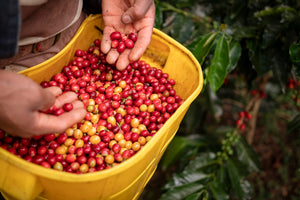When buying coffee, you might not think much beyond the brand of beans you toss into your cart or the friendly smile from the barista or vendor at the farmers market. But how your coffee is grown greatly impacts its flavor, your health, and most of all, the health of the planet.
You’re likely familiar with shade-grown or biodynamic coffee, but regenerative organic is the most advanced certification in coffee farming and starts with the soil where it’s grown. Imagine a farmer in Brazil waking up as the sun rises, checking the cover crops that protect the soil, and adding organic compost as the birds chirp among the trees planted alongside his coffee plants. He knows that healthy soil and a diverse ecosystem lead to delicious coffee – and that his farm will last.
Regenerative Coffee is produced using regenerative agriculture practices that not only sustain the ability to farm, but actively restore and enhance our ecosystem. Unlike conventional coffee farming methods, regenerative coffee focuses on improving soil health, increasing biodiversity, and combating climate change through carbon sequestration. This holistic approach to farming ensures that the land is continuously revitalized, providing long-term benefits for the environment and the coffee produced. It’s a wonder why anyone decided to farm any other way.
Farming Techniques Behind Regenerative Coffee
Conventional coffee farming typically involves single-crop plantations, clear-cutting trees for sun, and heavy use of chemical fertilizers and pesticides to increase crop yield and control pests. Unfortunately, this leads to soil degradation, reduced biodiversity, and environmental (and dietary) pollution.
Regenerative coffee farming methods are the opposite. The focus is on improving soil health and increasing crop resilience so the land remains healthy and productive. Regenerative coffee farms rely on things like:

- Cover Cropping: This technique involves planting cover crops like sunn hemp or clover that protect and enrich the soil, reduce erosion, enhance fertility, and improve water retention. Once the coffee is harvested, the cover crops are often mulched, used for livestock grazing, or left to decompose naturally.
- Composting: Composting organic matter adds valuable nutrients back to the soil, promoting healthy plant growth and reducing the need for chemical fertilizers. Creating a strong microbial community also helps protect the coffee plants from disease and pests.
- Agroforestry: Planting trees among crops and livestock helps sequester carbon, improve soil health, and create a more diverse and resilient farming ecosystem. Inga trees are often used on coffee farms because they provide the necessary nitrogen and plenty of shade without interfering with coffee plant growth.
- Shade Management: Properly managing shade trees creates the perfect environment for coffee plants. It reduces heat stress, conserves soil moisture, and encourages biodiversity which contributes to healthier coffee plants.
- Intercropping: Growing coffee alongside other crops like bananas and avocados increases biodiversity and reduces pest and disease problems. This approach also diversifies farmers' income sources, making their livelihoods more secure.
- Integrated Pest Management (IPM): IPM includes introducing natural predators like ladybugs to control pests, using organic pesticides like neem oil, and employing techniques like crop rotation and mechanical traps to monitor and manage pests.
- Soil Conservation: Techniques like contour planting and terracing (planting along natural land contours or creating leveled areas on hillsides) are crucial for preventing soil erosion. They help maintain soil fertility and improve water retention to keep the land productive and useful.
How Regenerative Agriculture Improves the Environment
Regenerative agriculture has been used for thousands of years to sustainably manage land and resources. Following the key principles of soil health, biodiversity, carbon sequestration, and water management, farmers were able to grow the plants needed using the natural resources around them. These same principles are still used today in regenerative farming as a commitment to sustainability.
Improved Soil Structure and Reduced Erosion
Techniques like cover cropping and reduced tilling improve soil structure and fertility while reducing erosion. Healthier soil means better water retention and less reliance on chemical fertilizers, leading to cleaner water supplies and a more resilient agricultural system.
Increased Biodiversity and Ecosystem Resilience

Adding a mix of plants and animals to a farm makes it stronger against storms, droughts, and pests. This biodiversity helps with pollination and enriches the soil creating a healthy farm that can bounce back from environmental challenges. Diverse plant roots also hold the soil together better, reducing runoff and filtering pollutants, which helps keep water clean.
The FAO reports that biodiversity in agroecosystems is critical for food security and sustainability. Plants attract beneficial insects and animals that provide natural fertilizer and help with pest control. Healthy farms that are more resilient to environmental stresses is how we can ensure a continuous food supply.
Enhanced Carbon Capture and Reduced Greenhouse Gases
Techniques like agroforestry, which involves integrating trees with crops and livestock, help capture carbon dioxide from the atmosphere and store it in the soil. This reduces greenhouse gases and improves soil health and productivity.
Regenerative farming and crop rotation methods can sequester up to 2 tons of CO2 per hectare annually, and, when combined with other techniques, could sequester all the carbon being emitted which would help reverse climate change.
Better Water Management and Reduced Pollution

To keep plants growing, regenerative farmers often use drip irrigation for more precise watering and less waste. They often manage their water supply through rainwater collection so they can water their crops even during dry periods. Keeping their soil healthy with natural fertilizers and pest management methods will also reduce water pollution from any runoff.
Quality and Taste: Why Regenerative Coffee Stands Out

While supporting the environment and our own health should be our priority, we also want a delicious cup of coffee. So how does regenerative coffee compare to coffee from conventional farms?
Good news – regenerative farming practices contribute to an even better coffee flavor. Not only does healthier soil enhance the flavor of your coffee, but it improves the nutritional value. Crops from regenerative farms tend to be more nutrient-dense, with higher levels of vitamins and minerals. The absence of chemicals also leads to a cleaner, more natural taste which means your cup of coffee is more delicious and better for your health.
How to Choose the Best Regenerative Organic Certified Coffee
Supporting regenerative coffee is easier than you might think. Here are some ways to identify and support regenerative coffee:

- Understand Certifications and Labels: Look for certifications like Regenerative Organic Certificated, in addition to Fair Trade, USDA Organic, or Rainforest Alliance. These labels ensure the coffee adheres to strict regenerative agricultural practices.
- Research Brands: Choose brands that provide detailed information about their supply chain, farming practices, and commitment to regenerative agriculture. Check the brand’s mission statements and sustainability reports to ensure they focus on regenerative practices.
- Directly Support Farmers: Support local and small-scale farmers who are more likely to use regenerative methods by buying from local markets or direct trade models. Personal connections with farms or reading their stories can provide assurance about their farming practices.
- Product Information: Look for packaging details about regenerative practices, soil health, and biodiversity. Brands committed to regenerative agriculture often provide educational resources about their processes on their websites or through QR codes on packaging.
- Ask Questions: Contact brands directly to inquire about their farming practices. Brands dedicated to regenerative agriculture will be transparent about their methods and benefits. Ask coffee shops and retailers about the sourcing and farming practices of their coffee and encourage them to stock more regenerative options.
Join the Regenerative Coffee Movement

According to Regenerative Organic Alliance, industrial agriculture is responsible for up to 25% of the greenhouse gas emissions fueling the climate crisis which means there’s a huge opportunity for positive change. If we shift to regenerative farming all over the world, we could solve about a third of land-based climate problems by 2030.
As a consumer, you can create the biggest change. By making the switch to regenerative coffee you’ll be supporting farmers who choose sustainable practices and help drive us toward a healthier planet.
Are you in the Denver area? Look for our Regenerative Organic Certified coffee at NewTopia Now beginning August 18th!


